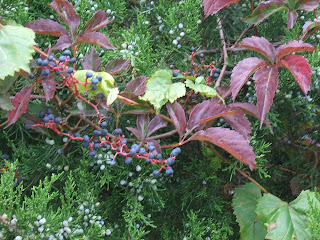
Today I shopped at a rummage sale, and I intend to visit at least two more this fall. Rummage sales are one of my favorite ways to reuse, from the great trilogy of "reduce, reuse and recycle." I know some people who prefer garage sales, and some swear by flea markets or thrift shops. I prefer rummage sales because everything is already sorted for you, and if you are looking for children's books or men's shirts they will probably all be at one table or rack. Also at the end of the sale everything unsold has to be packed up, so there are further markdowns.
In general, I try to avoid buying new things except food and toiletries. Mining, logging, drilling for oil, farming and manufacturing all use lots of energy and create lots of waste. Most of these impacts are far away where I never see them, but I am still responsible for my share. If I object to the number of trucks on the road and the pollution from diesel engines, the exploitation of workers around the globe, or destruction of the earth's natural resources, I should just buy less stuff. So I try to take good care of what I have, repair what is broken, share and borrow, find someone to use what I can't use anymore, and buy secondhand.
Here's why I try to avoid buying new clothes. Synthetic fibers are usually made from petroleum, take a lot of energy to produce, and aren't biodegradable. I used to think that because cotton was a natural fiber it was good for the earth, but I have since learned that growing conventional cotton is very bad for the environment. I remembered from American history that cotton is a crop that depletes the soil, and it turns out that cotton uses more pesticides than any other crop in the world, an outrageous amount. The pesticides used on food are regulated to make sure that they break down quickly or aren't too toxic, but we don't eat cotton, so more toxic or longer-lasting pesticides are used on it. As a result, it turns out that cotton is anything but natural or kind to the earth. There is organic cotton, and I try to buy sheets and towels made from organic cotton. I've read that all Egyptian cotton is organic, but during harvest season the children in the farming areas are taken out of school and pick cotton for a month or two, so I avoid Egyptian cotton. I get a couple of catalogs that carry organic cotton and hemp clothing, but I rarely find anything I like and need in my size.
Furthermore, dying is very bad for the environment. Even if the dye is natural, and they rarely are, the chemicals used to set the dye cause pollution. Organic cotton or hemp clothing, which are usually made by environmentally responsible companies, sometimes feature low-impact dyes, but once again the selection is not vast.
All of which brings me to rummage sales.
Today I arrived in time for the last hour of the rummage sale, and I missed lots of the best items. At that point in the sale the shopper must buy a bag (a paper grocery bag) for $3 and then may fill it with whatever fits in the bag. I bought three bags and filled them with: a covered plastic coffee cup that says "reduce, reuse and recycle" on it, a wine glass, six flower vases, two picture frames (for a dollar extra), 12 cloth napkins, a coat with a removable lining, one skirt, one dress, one linen jacket, and 27 blouses and tops. I didn't get to try anything on at the sale except the coat, and I couldn't even see myself in the mirror. However, the staff or other shoppers will usually give an opinion if asked. I even have friends I see at every rummage sale, who give me advice and point out clothes that they think will suit me. I am lucky because if those 27 blouses and tops don't fit me, they might fit my daughter. And if not, I can always donate them to another rummage sale!
I only picked up those six flower vases at the last minute when the staff called out "everything is free!" When I got home I found that one of the free vases is stamped on the bottom with the words "Coors Golden Colorado Pottery." I searched the internet and found similar vases selling for $50 to $60, so mine is a pretty good bargain and a nice addition to my pottery collection (see photo). My daughter wants three of the tops and the dress, and I think I will be able to wear fourteen of the tops. That leaves ten to donate to another sale.
One friend of mine from time to time gives a party, a women's clothing exchange. She sets up some racks and a mirror, and invites her (female) friends to bring all the clothes they no longer want and something to eat. We hang up the clothes we have brought and try on everyone else's contributions. Then we eat. We all go home with new clothes. One year I was surprised to find two new dresses that fit me that had previously belonged to women who were eleven inches shorter than I am. You never know! So, try giving a clothing exchange party or attend one if you are invited. It is one of the most fun ways I can think of to reuse.






















+for+webpage+display.jpg)